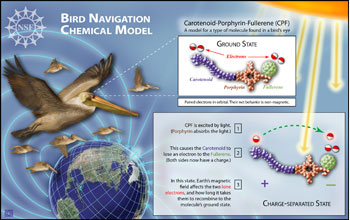Multimedia Gallery
Bird Navigation Chemical Model
An international team of researchers are the first to demonstrate that a synthesized photochemical molecule composed of linked carotenoid (C), porphyrin (P) and fullerene (F) (CPF) units can act as a magnetic compass. When excited with light, CPF forms a short-lived charge-separated state with a negative charge on the ball-like fullerene unit and a positive charge on the rod-like carotenoid unit. The lifetime of the charge-separated state before it returns to its lowest energy or ground state is sensitive to the magnitude and direction of a weak magnetic field similar to Earth's.
This image accompanied NSF press release, "Research Team Is First to Model Photochemical Compass for Bird Navigation."
Credit: Zina Deretsky, National Science Foundation
Images and other media in the National Science Foundation Multimedia Gallery are available for use in print and electronic material by NSF employees, members of the media, university staff, teachers and the general public. All media in the gallery are intended for personal, educational and nonprofit/non-commercial use only.
Images credited to the National Science Foundation, a federal agency, are in the public domain. The images were created by employees of the United States Government as part of their official duties or prepared by contractors as "works for hire" for NSF. You may freely use NSF-credited images and, at your discretion, credit NSF with a "Courtesy: National Science Foundation" notation.
Additional information about general usage can be found in Conditions.
Also Available:
Download the high-resolution JPG version of the image. (956 KB)
Use your mouse to right-click (Mac users may need to Ctrl-click) the link above and choose the option that will save the file or target to your computer.

